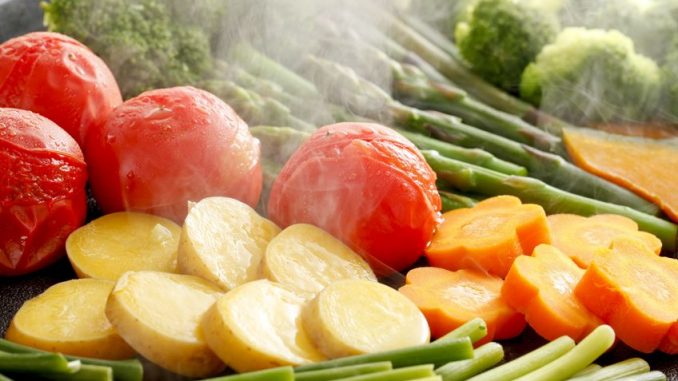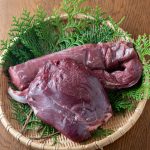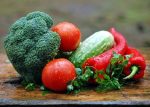
Steam cooking comes in many guises. As one of the top thermo-mechanical processes open to us is steam jet-cooking which has been used in a variety of industries. In the kitchen, many are familiar with pressure cookers which consist of a pot and a cover fixed to that pot with an air-tight closure. The lid is firmly fixed down to resist the rise in pressure.
The Chinese regard steam cooking along with pan searing, stir-frying and deep-frying as one of the four essential cooking techniques in their style of cooking. It doesn’t matter what is cooked using steam:- meat, fish, vegetables can all be prepared this way. The selection of the method in cooking depends on the desired result and that which brings out the best in the ingredients. For the Chinese in particular, steam cooking is the number one choice when handling the freshest of ingredients.
Steam cooking is a healthy option because it uses steam rather than oil or fat for cooking with. It is essential that the ingredients are as fresh as possible to maximise the benefits of the steam process. It is a very simple technique and is energy conserving. Compared to conventional oven cooking, a product takes a third of the time to cook using steam because the temperature rise is so high.
Many products rely on moisture retention for their quality. Meats such as chicken and seafood benefit best when steam cooking is applied because it preserves their fine texture
Steam-Injection Cooking
Steam-injection cooking is often applied to liquid foods. It is commonly compared to steam infusion cooking and ultra high temperature temperature processing (UHT). It offers a very short cooking time because the steam is applied at high pressure with high shear and temperatures that exceed 100 Centigrade.
There have been many different types of direct steam injection. It involves adding steam through apertures around the skin of the vessel or through a lance situated inside the vessel. It involves discharging a series of steam bubbles into the product. According to the steam infusion group at the University of Lincoln, “steam injectors are engineered to create a turbulent zone within the steam injector body to help mix the steam and product. This allows for slightly higher operating steam pressures than a rudimentary sparge pipe. One of the key challenges around efficiency is that steam bubbles can easily reach and break the surface, escaping to atmosphere.”
Steam-Infusion Cooking
Steam-infusion cooking is a form of direct-contact heating where steam condenses on the surface of a liquid food product. Unlike more aggressive steam-based heat process, the main value is a rapid but gentle heating of foods, especially those which have a significant viscosity but can be pumped around. Good examples are sauces, soymilks, cream and soups.
The alternative method to which it is compared is steam injection and other forms of steam heating usually in jacketed vessels.
Steam infusion was first developed in the early 1960s by APV using the Palarisator brand name. Subsequently, Pursuit Dynamics developed a process in 2000 using marine propulsion as the basis. A supersonic steam is generated which is added to the food/process flowing in the system. This entrains and vaporises the process flow to form a multiphase flow, which heats the suspended particles by surface conduction and condensation. The condensation of the steam causes the process flow to return to a liquid state. This causes rapid and uniform heating over the unit making it applicable to industrial cooking processes. The main benefit is in soup and sauce cooking. Pursuit Dynamics Plc near Peterborough are now the owners and developers of the technology.
Another related process has been developed at the National Centre for Food Manufacturing which is in the University of Lincoln, UK. Its key piece of technology is a Steam Infusion Vaction Pump. The benefits of this pump are that it operates as a lance that sits inside a cooking vessel or integrated processing line. It can heat up to 1 Tonne of product from 15°C to 90°C in a few minutes. There is no particulate damage or burning of the product.
The cooking lance can also be retrofitted into new or existing cooking vessels. It can achieve twice the cooking capacity.
Whole grains & rice
Most flaked products especially whole grains are cooked using steam. Any food stuff containing corn grits, starch or other floury materials produces a better cooked product because there is less structural disruption than when boiling water cookers are used. With steam, as we’ve mentioned before the product retains its integrity.
Rice is ideally cooked using steam and dim sum is never cooked by any other method.
The Steam Cooking Of Starch Products: Enter Steam-Jet Cooking
Starch is normally found as discrete granules and these are insoluble in water at room temperature. The reason is the hydrogen bonding between the starch molecules which are in the form of helices and they have a crystalline structure,
Starch solutions using conventional cooking methods are tricky to produce. However, steam jet cooking is a rapid and continuous method that has been used for many years now to cook aqueous starch solutions on an industrial scale. A slurry of starch with water is prepared and passed continuously through the steam jet cooker (Winfrey & Black, 1964; Klein & Brogley, 1981). The paper industry has used the technology since the 50s.
The technology generally involves pumping an aqueous starch slurry through an orifice where it is mixed with steam at very high temperature and pressure. Typical temperatures might be up to 150°C delivered at over 65 psig line pressure to create a pressure of 40 psig in the cooking unit.
Intense turbulence results from condensation of the high pressure steam and the movement of excess steam through the cooker. It not only causes rupturing of the starch granule but also solubilization of the starch as water mixes into the granule. The solution viscosity, which is high to begin with drops with this process because mechanical shearing occurs to the starch macormolecules.
The Plant Polymer and the Phytoproducts Research groups at the National Center for Agricultural Utilization Research in Peoria, Illinois USA has conducted a great deal of research into what happens to starch solutions when they are cooked using this technology. Whilst research on starch cooking was reasonably well understood, foodstuffs are heterogeneous involving many more different types of ingredient and this team has written a number of articles about blends and complexes of starch, the role of co-jet cooking and the effects of both monomeric and polymeric types of compounds on a host of properties.
The effect of hydrocolloids such as poly(ethylene-co-acrylic acid) (Fanta et al., 1992) or guar (Fanta & Christianson, 1995) mixed with starch is well understood.
Steam-jet cooking is an effective approach to generating uniform dispersions of lipids in starch-water complexes (Fanta & Eskins, 1995). The turbulence coupled with high temperature is ideal for this type of mixing. Small droplets of lipid between 10 and 50 microns are created that will not separate or coalesce. You can observe them after a few hours of the starch-water-lipid droplet mixture left on standing.
The interest to food developers of this approach is enormous because such compositions are used as fat replacers and food stabilizers, or in cosmetics and adhesives, and most interestingly in drug delivery systems.
Typical lipids include soybean, olive, hydrogenated vegetable oils, paraffin oil, butter or maize oil, or combinations. Compositions of starch to oil are usually prepared in the ratios of between 1 part oil to 5 parts starch. No emulsifiers were needed to create a stable dispersion after jet-steam cooking.
The reason the dispersions are so stable is because the jet cooked starch solutions have a high viscosity which physically holds droplets in suspension.
Starch and lipid or fatty acid mixtures produce helical inclusion complexes (Hahn & Hood, 1987; Eliasson et al., 1988; Huang & White, 1993; Fanta et al., 1999).
Wheat flour replacement with raw or steam jet-cooked barley flour produced batters with less oil uptake than other batters. If wheat flour is substituted with 5% steam jet-cooked barley flour then fried samples are produced with about 7% less oil (Lee and Inglett, 2006).
Various cereal flakes can be steam jet cooked to produce novel textures. Oat starch is particularly amenable to this type of steam cooking.
Steam Cooking Vegetables
Vegetables are ideally steamed. The high heat with moist air means there is consistency in the cooking process from the surface to the core of the vegetable without losing taste.
Steam cooking is ideal for those vegetables destined to be used in ready-to-eat meals, especially those which in tray packs. The nutritional quality of steam cooked vegetables without any liquid carriers is better because leaching loss is minimised. It is more convenient to process the vegetables in steam and then transfer them to pre-weighed batches in the tray pack (Pannu & Castaigne, 2000). In many of these processes the vegetables are contained in trays with perforated bottoms which allows for the free flow of steam through the food bed. Generally, the flow-rate is controlled by a throttle valve at the discharge end. The steam mass flow rate (SMFR) was determined by condensing steam and collecting the condensate. In most cases the vegetables are cooked at 121 Centigrade. Cubing the vegetables helps with uniform cooking.
Steam blanching has also been employed as a method for inactivating enzymes prior to non-thermal processing of foodstuffs. The idea being to reduce the impact of enzyme activation and reduce enzyme recovery following high pressure processing.
Nutrient Losses
Steaming of any sort causes less damage to nutrients. Vitamin C is notoriously susceptible to destruction during cooking. Boiling with microwaving or with frying causes high losses of vitamin C (Lee and Kader, 2000; Serrano et al., 2006). Steaming on the other hand causes less of a loss. It’s probable that with any water-soluble nutrient like vitamin C that it leaches away in the cooking medium rather than by thermal degradation.
Continuous Steam Pre-Cooking
Steam cooking is usually done in batch cookers but continuous steam cookers are available when used in conjunction with extrusion (Frame, 2012). The idea here is to hydrate the product prior to extrusion cooking. It is often applied to cereal products before they enter the extrusion step. Steam pre-cooking has a number of advantages in this respect:-
- Starch is less damaged. The longer, more gentle processing of steam cooking reduces starch damage and there is a better uniformity in hydration.
- Less energy is expended during extrusion. Electricity costs are claimed to be reduced because extrusion is such an energy intensive process.
Steam precookers are usually placed before the extruder inlet. The product grain flows under gravity through the cooker into the extruder. Steam with water is mixed with the product by one or two sets of mixing elements which are often paddle blades mounted on parallel rotating shafts. These precookers tend to operate at near to atmospheric pressure or slightly above. The product has a residence time of up to two minutes in the precooker.
Superheated Steam Ovens
Superheated steam ovens are becoming a must have item in the kitchen and work as effectively as microwave ovens. Cooked meats such as chicken seem to have a better nutrient retention compared to boiled, grilled and microwave cooked chicken pieces.
Superheated steam cooking uses steam heated above its boiling point to cook and crisp vegetables without oil. The steam prevents oxidation while dehydrating the food.
Advantages
- Oil-Free: Produces crunchy snacks without deep frying.
- Nutrient Retention: Protects heat-sensitive compounds like vitamins.
- Crispy Texture: Achieves a roasted or toasted effect.
Applications
- Producing crispy zucchini slices, eggplant chips, and roasted chickpeas.
References
Cao, X.M., Bi, X. F., Huang,W. S., Wu, J. H., Hu, X. S., & Liao, X. J. (2012). Changes of quality of high hydrostatic pressure processed cloudy and clear strawberry juices during storage. Innovative Food Science and Emerging Technologies, 16, pp. 181–190
Eliasson, A.-C., Finstad, H. & Ljunger, G. (1988). A study of starch-lipid interactions for some native and modified maize starches. Starch/Starke, 40, pp. 95
Fanta, G.F. & Christianson, D.O. (1995). Starch-hydrocolloid composites prepared by steam jet cooking. Food Hydrocolloids.
Fanta, G.F., Dintzis, F.R., Bagley, E.B. & Christianson, D.O. (1992). The influence of pH on the viscous behavior of starch-poly(ethylene-co-acrylic acid) complexes. Carbohydr. Polym., 19, pp. 253
Fanta, G.F., Eskins, K. (1995) Stable starch-lipid compositions prepared by steam jet cooking. Carb. Polym. 28 pp. 171-175
Fanta, G. F., Shogren, R. L., & Salch, J. H. (1999). Steam jet cooking of high-amylose starch–fatty acid mixtures. An investigation of complex formation. Carbohydrate Polymers, 38(1), pp. 1-6 (Article).
Frame, N.D. (2012) The Technology of Extrusion Cooking. Springer Science & Business Media. 253 pages
Hahn, D.E. & Hood, L.F. (1987). Factors influencing corn starch-lipid complexing. Cereal Chem., 64, pp. 81.
Huang, J.J. & White, P.l. (1993). Waxy corn starch: monoglyceride interaction in a model system. Cereal Chem., 70, pp. 42
Klein, R.E. & Brogly, D.A. (1981). Method for selecting the optimum starch binder preparation system. Pulp Paper, 55, pp. 98.
Lee, S., Inglett, G.E. (2006) Functional Characterization of Steam Jet‐Cooked β‐Glucan‐Rich Barley Flour as an Oil Barrier in Frying Batters. J. Food Sci., 71 (6) E308-313 (Article)
Lee, S.K., Kader, A.A. (2000) Preharvest and postharvest factors influencing vitamin C content of horticultural crops. Postharvest Biol. Technol., 20(3) pp. 207-220. [doi: 10.1016/S0925-5214(00)00133-2]
Lee, S., Warner, K., Inglett, G.E. (2005) Rheological properties and baking performance of new oat β-glucan-rich hydrocolloids. J. Agric. Food Chem. 53 (25) pp. 9805–9
Pannu, K.S. Castaigne, F. (2000) Batch Cooking of diced vegetables with pressurized steam and no liquids. Technical Abstract 24-2 2000 IFT Annual Meeting, June 10 – 14, Dallas, TX
Serrano, M., Martinez-Romero, D., Guillen, F., Castillo, S., Valero, D., (2006). Maintenance of broccoli quality and functional properties during cold storage as affected by modified atmosphere packaging. Postharvest Biol. Technol., 39(1) pp. 61-68. [https://doi:10.1016/j.postharvbio.2005.08.004]
Winfrey, V.L. & Black, W.E. (1964). U.S. Patent 3,133,836.



Leave a Reply